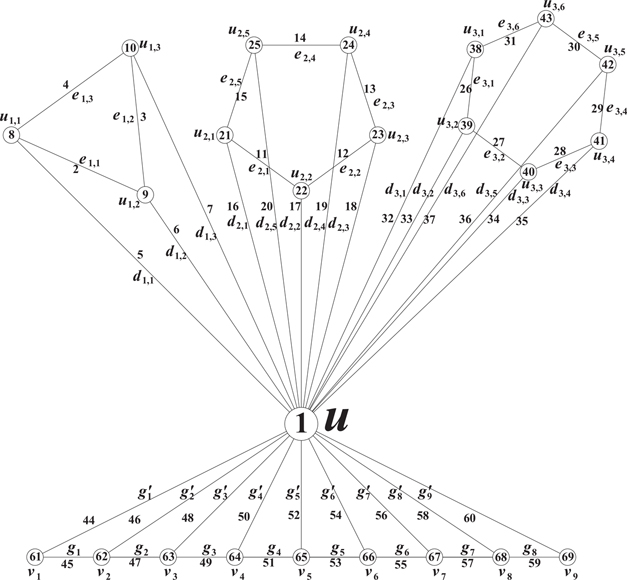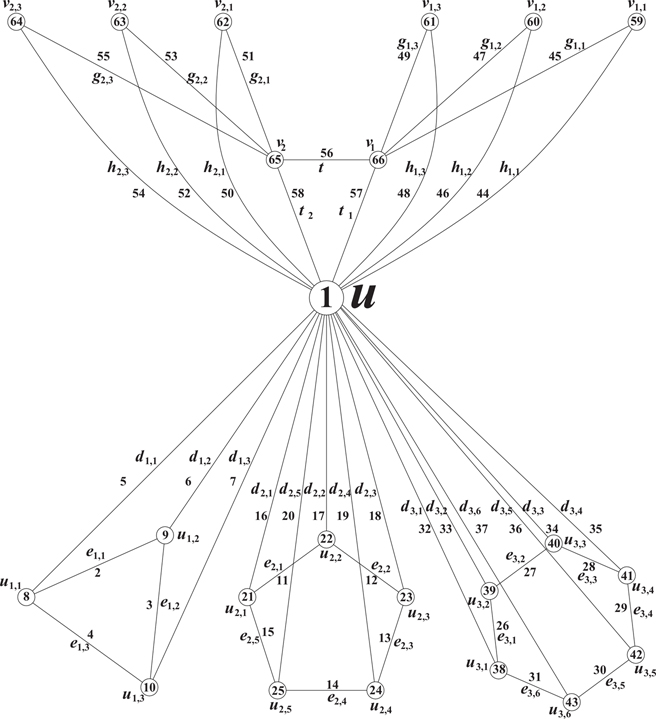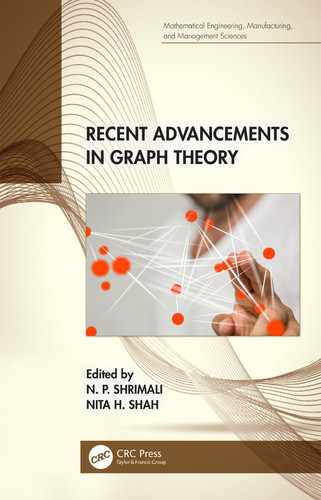N P Shrimali
Department of Mathematics,
Gujarat University,
Ahmedabad, Gujarat (INDIA)
E-mail: [email protected]
A K Rathod
Department of Mathematics,
Gujarat University,
Ahmedabad, Gujarat (INDIA)
E-mail: [email protected]
Let G be a graph with V(G) as the vertex set and E(G) as the edge set. A bijective function is said to be a total neighborhood prime labeling, if for each vertex in G having degree greater than 1, the gcd of the labels of its neighborhood vertices is 1 and the gcd of the labels of its induced edges is 1. A graph which admits a total neighborhood prime labeling is called a total neighborhood prime graph. In this chapter, we investigate total neighborhood prime labeling for some join graphs.
12.1Introduction and Definitions
In this chapter, we consider the simple, finite, connected and undirected graph G = (V(G), E(G)) with V(G) as vertex set and E(G) as edge set. For various notations and terminology of graph theory, we follow Gross and Yellen [3] and for some results of number theory, we follow Burton [2].
Let G be a graph with n vertices. A bijective function is said to be a neighborhood-prime labeling if for every vertex u in V(G) with deg(u) > 1, gcd , where N(u) = . A graph which admits neighborhood-prime labeling is called a neighborhood-prime graph.
The notion of neighborhood-prime labeling was introduced by Patel and Shrimali [4]. In [5] they proved the union of some graphs are neighborhood-prime graphs. They also proved that the product of some graphs are neighborhood-prime [6]. For a further list of results regarding neighborhood-prime graphs the reader may refer to [1].
In a neighborhood-prime labeling, edges are not considered. Kumar and Varkey extended the condition on edges and they defined total neighborhood prime labeling [7].
Definition (Total neighborhood prime labeling). Let G be a graph. For u ∈ V(G),
A bijective function is said to be a total neighborhood prime labeling, if for each vertex u with degree greater than 1, gcd and . A graph which admits total neighborhood prime labeling is called a total neighborhood prime graph.
Kumar and Varkey proved that path, cycle C4k and comb graphs admit total neighborhood prime labeling [7]. Shrimali and Pandya proved comb, disjoint union of paths, disjoint union of sunlet graphs, disjoint union of wheel graphs, graph obtained by one copy of path Pn and n copies of K1,m and joining ith vertex of Pn with an edge to fixed vertex in the ith copy of K1,m, corona product of cycle with m copy of K1 and subdivision of bistar are total neighborhood prime graphs [8].
Definition (Armed crown). Armed crown is the graph obtained by attaching a path P2 at each vertex of cycle Cn. It is denoted by ACn.
Definition (Join graph) Let G1 = (V (G1), E(G1)) and G2 = (V (G2), E(G2)) be two graphs with no vertex in common. The join graph of G1 and G2 denoted by G1 + G2 is the graph with vertex set and edge set
Theorem 12.1
ACn + K1 is a total neighborhood prime graph.◼
Proof. Let G = ACn + K1. Let be the vertices of Cn , ui,1 and ui,2 be the vertices of ith copy of path P2 for each i in ACn and u be the vertex corresponding to K1. By the definition of join graph, u is adjacent to each vertex of a graph ACn, ui,1 is adjacent to ui,2 and ui for . Let di = ui ui+1(value of i is taken modulo n), ei,j = u ui,j and ei = u ui for and j = 1, 2 and gi,1 = ui ui,1, gi,2 = ui,1 ui,2 for .
So, vertex set and j = 1, 2} and edge set and j = 1, 2}
We define as follows.
f(u) = 1,
f(ui) = 8i − 1, 1 ≤ i ≤ n
f(ei) = 8(i − 1) + 4, 1 ≤ i ≤ n
f(di) = 8n + 1 + i, 1 ≤ i ≤ n
In order to prove f is a total neighborhood prime labeling, we have to show that both the conditions are satisfied by f. Let w be an arbitrary vertex in V(G). For w ≠ u, since f(u) = 1 and u ∈ NV(w), gcd {f(p)/p ∈ NV(w)} = 1 and for w = u, {f(p)/p ∈ NV(w)} contains at least two consecutive numbers, so gcd {f(p)/p ∈ NV(w)} = 1. For any vertex w, {f(e)/e ∈ NE(w)} contains at least two consecutive numbers or consecutive odd numbers, so gcd {f(e)/e ∈ NE(w)} = 1. Therefore, f is a total neighborhood prime labeling. Hence, G is a total neighborhood prime graph.□
Illustration 12.2.1. Total neighborhood prime labeling of AC4 + K1 is shown in Figure 12.1.

Theorem 12.2
is a total neighborhood prime graph.◼
Proof. Let . Let be the vertices of ith cycle where 1 ≤ i ≤ p and u be the vertex corresponding to K1. By the definition of join graph, u is adjacent to each vertex of . Let ei,j = ui,j ui,j+1 and di,j = u ui,j for 1 ≤ i ≤ p, 1 ≤ j ≤ ni where the value of j is taken modulo ni. Vertex set and and edge set and .
Now we define the function as follows.
f(u) = 1,
We will show that both the conditions for total neighborhood prime labeling are satisfied by f. Let w be an arbitrary vertex in V(G). For w ≠ u, gcd {f(p)/p ∈ NV(w)} = 1 because f(u) = 1 and u ∈ NV(w). For w = u, {f(p)/p ∈ NV(w)} contains at least two consecutive numbers, so gcd {f(p)/p ∈ NV(w)} = 1. For any vertex w, {f(e)/e ∈ NE(w)} contains at least two consecutive numbers or consecutive odd numbers, so gcd {f(e)/e ∈ NE(w)} = 1. Therefore, f is a total neighborhood prime labeling and G is a total neighborhood prime graph.□
Illustration 12.2.2. Total neighborhood prime labeling of is shown in Figure 12.2.

Theorem 12.3
is a total neighborhood prime graph.◼
Proof. Let . Let be the consecutive vertices of path Pn and be the vertices of ith cycle where 1 ≤ i ≤ p. Let u be the vertex corresponding to K1. So by the definition of join graph, u is adjacent to each vertex of . Let ei,j = ui,j ui,j+1 and di,j = u ui,j for 1 ≤ i ≤ p, 1 ≤ j ≤ ni where value of j is taken modulo ni. Let gi = vivi+1 for and gi′ = uvi for .
Vertex set and and edge set and .
Now we define the function as follows.
f(u) = 1,
, 1 ≤ i ≤ n,
, 1 ≤ i ≤ n − 1,
, 1 ≤ i ≤ n.
Let w be an arbitrary vertex in V(G). For w ≠ u, since f(u) = 1 and u ∈ NV(w), gcd {f(p)/p ∈ NV(w)} = 1 and for w = u, gcd {f(p)/p ∈ NV(w)} = 1 because {f(p)/p ∈ NV(w)} contains at least two consecutive numbers. For any vertex w, gcd {f(e)/e ∈ NE(w)} = 1 because {f(e)/e ∈ NE(w)} contains at least two consecutive numbers or consecutive odd numbers. Since both the conditions for total neighborhood prime labeling are satisfied, f is a total neighborhood prime labeling and hence G is a total neighborhood prime graph.□
Illustration 12.2.3. Total neighborhood prime labeling of +K1 is shown in Figure 12.3.

Theorem 12.4
+K1 is a total neighborhood prime graph.◼
Proof. Let . Let be the vertices of star graph K1,n where v is the apex vertex. Let be the vertices of ith cycle where 1 ≤ i ≤ p. Let u be the vertex corresponding to K1. So by the definition of join graph, u is adjacent to each vertex of . Let ei,j = ui,j ui,j+1 and di,j = u ui,j for 1 ≤ i ≤ p, 1 ≤ j ≤ ni where value of j is modulo ni. Let gi = uvi, hi = vvi for and e = uv.
Vertex set and and edge set and .
Now we define the function as follows.
f(u) = 1,
, 1 ≤ i ≤ n,
, 1 ≤ i ≤ n,
, 1 ≤ i ≤ n,
,
.
Let w be an arbitrary vertex in V(G). For w ≠ u, gcd {f(p)/p ∈ NV(w)} = 1 because f(u) = 1 and u ∈ NV(w). For w = u, since {f(p)/p ∈ NV(w)} contains at least two consecutive numbers, gcd {f(p)/p ∈ NV(w)} = 1 . For any vertex w, {f(e)/e ∈ NE(w)} contains at least two consecutive numbers or consecutive odd numbers, so gcd {f(e)/e ∈ NE(w)} = 1. Therefore, f is a total neighborhood prime labeling. Thus, G is a total neighborhood prime graph.
Illustration 12.2.4. Total neighborhood prime labeling of is shown in Figure 12.4.

Theorem 12.5
is a total neighborhood prime graph.□
Proof. Let . Let , be the vertices of bistar graph Bm,n where are adjacent to v1 and are adjacent to v2. Let be the vertices of ith cycle where 1 ≤ i ≤ p. Let u be the vertex corresponding to K1. So by the definition of join graph, u is adjacent to each vertex of . Let ei,j = ui,j ui,j+1 and di,j = u ui,j for 1 ≤ i ≤ p, 1 ≤ j ≤ ni where the value of j is taken modulo ni. Let gi,j = vivi,j and hi,j = uvi,j for i = 1, and for i = 2, . let t = v1 v2 and ti = uvi for i = 1, 2.
Vertex set and and edge set and .
Now we define the function as follows.
f(u) = 1,
, i = 1, 2,
, i = 1, 2,
.
Let w be an arbitrary vertex in V(G). For w ≠ u, since f(u) = 1 and u ∈ NV(w), gcd {f(p)/p ∈ NV(w)} = 1 and for w = u, gcd {f(p)/p ∈ NV(w)} = 1 because {f(p)/p ∈ NV(w)} contains at least two consecutive numbers. For any vertex w, gcd {f(e)/e ∈ NE(w)} = 1 because {f(e)/e ∈ NE(w)} contains at least two consecutive numbers or consecutive odd numbers. Since both the conditions for total neighborhood prime labeling are satisfied, f is a total neighborhood prime labeling and G is a total neighborhood prime graph.□
Illustration 12.2.5. Total neighborhood prime labeling of is shown in Figure 12.5.

Theorem 12.6
is a total neighborhood prime graph.◼
Proof. Let . Let be the vertices of comb graph for j = 1, 2. vi,1 is adjacent to vi−1,1 and vi+1,1 for . vi,1 is also adjacent vi,2 for . Let be the vertices of ith cycle where 1 ≤ i ≤ p. Let u be the vertex corresponding to K1. So by the definition of join graph, u is adjacent to each vertex of . Let ei,j = ui,j ui,j+1 and di,j = u ui,j for 1 ≤ i ≤ p, 1 ≤ j ≤ ni where the value of j is taken modulo ni. Let gi = vi,1vi+1,1 for , gi′ = vi,1vi,2 for and hi,j = uvi,j for and j = 1, 2.
Vertex set and and edge set and .
Now we define the function as follows.
f(u) = 1,
, ,
,
Let w be an arbitrary vertex in V(G). For w ≠ u, gcd {f(p)/p ∈ NV(w)} = 1 because f(u) = 1 and u ∈ NV(w). For w = u, since {f(p)/p ∈ NV(w)} contains at least two consecutive numbers, gcd {f(p)/p ∈ NV(w)} = 1 . For any vertex w, {f(e)/e ∈ NE(w)} contains at least two consecutive numbers or consecutive odd numbers, so gcd {f(e)/e ∈ NE(w)} = 1. Since both the conditions for total neighborhood prime labeling are satisfied, f is a total neighborhood prime labeling and G is a total neighborhood prime graph.□
Illustration 12.2.6. Total neighborhood prime labeling of is shown in Figure 12.6.

References
1.J. A. Gallian. A dynamic survey of graph labeling. The Electronic Journal of Combinatorics, #DS6, 2018.
2.D. M. Burton. Elementary Number Theory. Seventh Edition, McGraw-Hill Publisher, 2010.
3.J. Gross and J. Yellen. Graph Theory and its Applications. CRC Press, 2005.
4.S. K. Patel and N. P. Shrimali. Neighborhood-prime labeling. International Journal of Mathematics and Soft Computing, 5(2): 135-143, 2015.
5.S. K. Patel and N. P. Shrimali. Neighborhood-prime labeling of some union graphs. International Journal of Mathematics and Soft Computing, 6(1): 39-47, 2016.
6.S. K. Patel and N. P. Shrimali. Neighborhood-prime labeling of some product graphs. Algebra and Discrete Mathematics, 25(1): 118-129, 2018.
7.Rajesh Kumar and Mathew Varkey. A note on Total neighborhood prime labeling. International Journal of Pure and Applied Mathematics, 118(4): 1007-1013, 2018.
8.N. P. Shrimali and Parul B. Pandya. Total neighborhood prime labeling of some graphs. International Journal of Scientific Research in Mathematical and Statistical Sciences, 5(6): 157-163, 2018.
